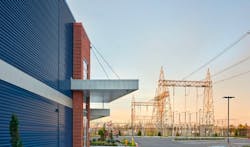Knowing the Power Grid is Critical for Data Center Site Selection
Stack Infrastructure and Data Center Frontier continue a new special report series by exploring the importance of “knowing the grid” in any location to successful data center site selection.
Get the full report.
Electrical power is one of the largest ongoing operational costs of running a data center. U.S.-based data centers alone consumed more than 90 billion kilowatt-hours of electricity in 2017, or 40% more electricity than that used by the 65 million people in the United Kingdom. This consumption is certain to change over time, as servers are continually packing more processing power into a smaller space. A decade ago, a typical server rack’s power density was in the 13kW to 5kW range. Today it isn’t unusual to find rack power density of up to 13kW range or more. A data center that is in operation for 30 years may thus see its power density requirements triple over that time, with a proportional increase in power and cooling demand
What are My Current and Future Power Requirements?
This process is different for every data center, but one approach is to calculate the nameplate power rating for all devices in use along with their voltage requirements and whether they are single-or three-phase devices. Because nameplate power requirements are the worst-case power consumption scenario as required by Underwriter’s Laboratory, actual power usage is likely to be at least one-third less.
Data center developers should request written copies of proposed increases in capacity, specifying right-of-way obligations, construction milestones and financial commitments.
Similar calculations should be performed for the operating power requirements of air handlers/ cooling/heating/ventilation equipment, lighting, uninterruptible power systems, generators, fire suppression systems and alarm systems. There are power consumption calculators available online that can help you with these calculations.
How Robust is the Grid?
If power capacity is constrained in the area, upgrades may be needed to support the data center. While current capacity may be sufficient, operators need assurance from the utility that service levels will be maintained if capacity requirements grow. Electric utilities move more slowly than hyperscale providers and are subject to more regulations and approvals. They also may operate on a first-come, first-served basis when accommodating additional demand. Data center developers should request written copies of proposed increases in capacity, specifying right-of-way obligations, construction milestones and financial commitments. These costs can total tens of millions of dollars, with the data center owner usually expected to bear much of the burden.
How Accessible are Renewable Energy Sources?
Green energy is an increasingly important consideration due to corporate social responsibility initiatives, demand from data center tenants and the need to reduce power costs. Data centers can reduce their power costs by leveraging sources such as solar, wind and biomass. This has the additional benefit of potentially mitigating public interest pressures that complicate siting and operation. Where 100% renewable sources aren’t practical, there may be offsets available that compensate for the power your facility consumes, such as an on-site solar farm.
Over the coming weeks, the special report series will also explore the following topics in relation to data center site selection: the value of knowing the grid, the network and your local stakeholders. Catch up on the first article in the series, as well.
Get the new special report, “Five Things To Know About Data Center Site Selection,” courtesy of Stack Infrastructure, to learn more about how to successfully approach the data center site selection process.


